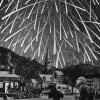
 Texas State Astronomers Solve
Texas State Astronomers Solve
Walt Whitman Meteor Mystery
In his landmark collection Leaves of Grass, famed poet Walt Whitman wrote of a “strange huge meteor-procession dazzling and clear shooting over our heads…” For decades, scholars have debated what astronomical event he was referring to.
Now, a team of astronomers from Texas State University has applied its unique brand of forensic astronomy to the question, rediscovering one of the most famous celestial events of Whitman’s day—one that inspired both Whitman and famed landscape painter Frederic Church—yet became inexplicably forgotten in recent times.
Texas State physics faculty members Donald Olson and Russell Doescher, English professor Marilynn S. Olson, and Honors Program student Ava G. Pope published their findings in the July 2010 edition of Sky & Telescope magazine, available on newsstands now.
Donald Olson noted that July 20 of this year is the 150th anniversary of the event that inspired both Whitman and Church. “It was an Earth-grazing meteor procession,” he said.
Whitman, known as a keen observer of the sky, included the reference to this event in his poem “Year of Meteors (1859-60),” published in Leaves of Grass.
“Meteor processions are so rare most people have never heard of them,” Olson said. “There was one in 1783 and a Canadian fireball procession in 1913. Those were all the meteor processions we knew of.”
An Earth-grazing meteor is one where the trajectory takes the meteor through the Earth’s atmosphere and back out into interplanetary space without its ever striking the ground. A meteor procession occurs when a meteor breaks up upon entering the atmosphere, creating multiple meteors traveling in nearly identical paths.
A chance clue from the 19th century artist Frederic Church proved key to unraveling the mystery. A decade ago, Olson saw a painting on the back cover of an exhibition catalog which showed the scene Whitman had described. Church’s painting, titled “The Meteor of 1860,” clearly depicted a meteor procession. Not only that, but the catalog gave the date of Church’s observance: July 20, 1860, well within the time frame of Whitman’s poem. An accomplished landscape painter, Church was a member of the Hudson River School, living beneath the same skies as Whitman.
Armed with this intriguing new date, the Texas State researchers began searching through newspapers of the time for verification. What they found surprised even them. A large Earth-grazing meteor broke apart on the evening of July 20, 1860, creating a spectacular procession of multiple fireballs visible from the Great Lakes to New York State as it burned through the atmosphere and continued out over the Atlantic Ocean.
“From all the observations in towns up and down the Hudson River Valley, we’re able to determine the meteor’s appearance down to the hour and minute,” Olson said. “Church observed it at 9:49 p.m. when the meteor passed overhead, and Walt Whitman would’ve seen it at the same time, give or take one minute.”
Some of the most influential publications in the United States—including the New York Times, Smithsonian and Harper’s Weekly—devoted major coverage to the event, and countless letters about it were published. Scientific American went so far as to declare it “the largest meteor that has ever been seen.”
“Its appearance, right before the Civil War, at a time of growth and anxiety for America, made it a metaphor and portent in the public imagination,” Marilynn Olson said.
You can contact Bob Eklund at [email protected], or visit his website at www.bobeklund.com.





Be the first to comment